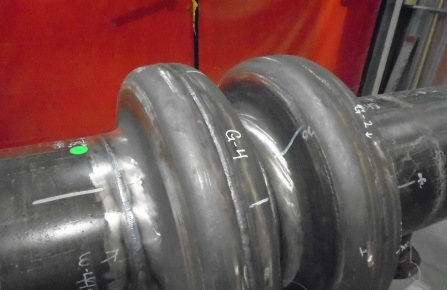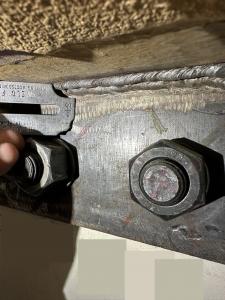Exploring the Value of Welding Evaluation in Industrial Applications: Guarding Against Failings and Enhancing Long Life
Welding assessment acts as a vital line of protection in industrial applications, making certain the structural honesty and dependability of welded parts. By systematically identifying defects such as porosity and incomplete fusion, examinations not only prevent failures but likewise prolong the lifespan of essential assets. Complying with sector standards enhances both safety and functional performance; nevertheless, the implications of neglecting these methods can be severe. As we take a look at the multifaceted benefits of regular inspections, it comes to be evident that comprehending these characteristics is not simply an issue of conformity yet a strategic critical for longevity and risk mitigation.
Function of Welding Evaluation
Welding inspection acts as an important guard in industrial applications, guaranteeing that bonded frameworks satisfy specified standards of quality and safety and security. This procedure includes a systematic examination of welds to validate their integrity, toughness, and conformity with well established codes and specifications. The duty of welding examination is diverse, encompassing both aesthetic evaluations and non-destructive screening techniques, which may consist of ultrasonic, radiographic, or magnetic bit screening.
Efficient welding inspection recognizes prospective concerns early, minimizing the threat of devastating failings that can develop from inadequate welds. By making certain that welds are performed according to design specs, inspectors add to the total architectural dependability and long life of elements in critical applications, such as stress vessels, pipes, and structural structures.

Common Welding Problems

One of one of the most widespread issues is porosity, identified by tiny gas pockets caught within the weld metal. This occurs due to contaminants or improper securing gas, endangering the weld's toughness. One more considerable issue is incomplete blend, where the weld steel stops working to bond appropriately with the base material, potentially bring about architectural weaknesses.

Splits can likewise develop during or after the welding process, often connected to thermal stress and anxieties or incorrect cooling rates. In addition, undercutting, where the base steel is worn down along the weld bead, can deteriorate the joint and is often brought on by excessive warmth input or inaccurate strategy.
Additionally, lack of infiltration occurs when the weld steel does not get to the root of the joint, leading to insufficient strength. Recognizing these typical defects is vital for welders and inspectors alike to guarantee that bonded structures fulfill security and efficiency criteria, eventually protecting against prospective failings in commercial applications.
Benefits of Regular Assessments
Regular evaluations offer as an important safeguard in guaranteeing the integrity and long life of welded structures. These analyses identify potential flaws and read the article weak points that might compromise the stability of welds, enabling prompt remediation prior to issues intensify. By implementing a structured examination routine, companies can considerably minimize the threat of disastrous failures that may cause pricey downtime, tools substitute, or also accidents.
Furthermore, routine evaluations add to improved high quality control throughout the welding process. By sticking to a regular inspection schedule, companies can make sure that their welding methods fulfill well established quality benchmarks and best practices. This not just cultivates a society of accountability but also encourages continual renovation amongst welding workers.
On top of that, routine evaluations help with better maintenance preparation. By recognizing deterioration early, organizations can strategically schedule repairs and substitutes, lessening disruption to operations. This aggressive technique ultimately leads to extensive possession lifespan and boosted total efficiency.
Lastly, a dedication to regular assessments can enhance a firm's credibility in the sector. Clients and stakeholders progressively worth organizations that focus on safety and high quality, thereby improving trust and possibly leading to boosted business chances.
Sector Criteria and Rules
Complying with market standards and guidelines is a fundamental element of welding inspection that matches the advantages of regular examinations. These criteria, developed by companies such as the American Welding Society (AWS) and the American Society of Mechanical Engineers (ASME), give a framework for best methods in welding procedures, products, and inspection techniques. Compliance with these guidelines makes certain that welds meet the required high quality and safety and security benchmarks, considerably minimizing the threat of architectural failings.
Regulatory bodies like the Occupational Safety and Health And Wellness Administration (OSHA) additionally implement standards that shield employees and the atmosphere during welding operations. By complying with these established requirements, markets can enhance the dependability of their structures and components, ensuring they perform as meant under numerous functional problems.
In addition, adherence to sector criteria fosters consistency in quality assurance, helping with smoother communication amongst stakeholders and governing agencies. This placement not just minimizes obligation threats however likewise improves the integrity of companies in competitive markets. Welding Inspection Gilbert Arizona. here are the findings Eventually, conformity with welding standards and laws is not simply a legal responsibility; it is an essential financial investment in security, performance, and long-term operational success
Future Trends in Welding Inspection
As sectors proceed to develop, the future of welding inspection is positioned to integrate sophisticated technologies that boost precision and efficiency. Among the most substantial fads is the adoption of automation and robotics in examination processes. Automated systems can perform evaluations rapidly, lowering human error and increasing throughput in producing settings.
Additionally, the integration of expert system (AI) and maker learning algorithms will make it possible for predictive analytics, enabling real-time assessments and positive upkeep. By assessing data from previous assessments, these technologies can determine patterns that can suggest possible failures, therefore expanding the life-span of bonded components.
Furthermore, non-destructive screening (NDT) techniques are expected to end up being much more innovative, making use of devices such as drones and autonomous automobiles furnished with innovative sensing units. Welding Inspection Gilbert Arizona. These developments will improve the capacity to inspect hazardous or hard-to-reach areas without jeopardizing security
In addition, the fad in the direction of digitalization will result in enhanced data administration systems that assist in far better monitoring, reporting, and conformity with sector criteria. In recap, the future of welding examination is characterized by technological advancements that promise to considerably enhance dependability, security, and operational effectiveness in numerous commercial applications.
Final Thought
In verdict, welding examination offers an essential feature in making certain the honesty and durability of bonded frameworks throughout different industrial applications. By recognizing defects such as porosity and insufficient blend, routine examinations play a significant role in risk reduction and quality control. Adherence to market standards and regulations better improves operational safety and integrity. As improvements in innovation remain to advance, the future of welding assessment guarantees increased precision and effectiveness, ultimately adding to the longevity of critical frameworks.
Welding inspection serves as a crucial line of protection in commercial applications, guaranteeing the architectural integrity and integrity of bonded components.Welding examination serves as a vital guard in commercial applications, making certain that welded structures fulfill defined standards of quality and safety and security. Ultimately, the function of welding examination is essential in advertising safety and security, enhancing efficiency, and protecting investments in industrial facilities.
These requirements, developed by companies such as the check this American Welding Culture (AWS) and the American Society of Mechanical Engineers (ASME), offer a structure for ideal practices in welding processes, materials, and evaluation methods.In conclusion, welding assessment offers a vital function in making sure the stability and longevity of bonded frameworks throughout different commercial applications.